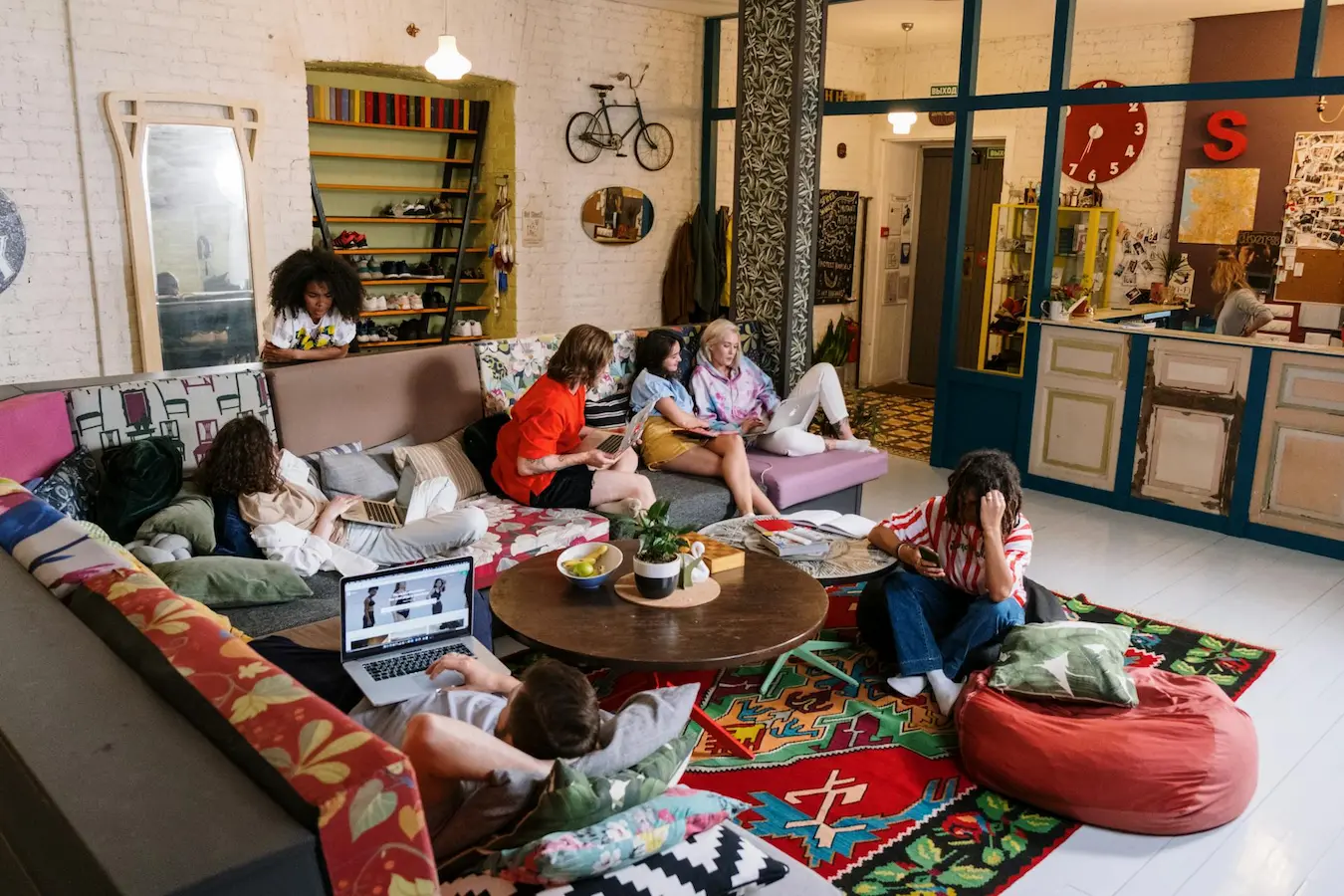Introducing Curvspace Common & Communal Areas
Curvspace redefines how we experience common communal areas, transforming them into vital components of modern living and working environments. For homeowners, Curvspace enhances property value by offering attractive amenities in intermediate and threshold spaces where residents transition seamlessly from public to private areas, boosting comfort and security. Tenants benefit from Curvspace’s thoughtfully designed lounges, gyms, and shared kitchens, which foster a tight-knit community and make the rental experience more enjoyable and engaging. Landlords find Curvspace invaluable in maximizing property appeal.
By integrating functional common spaces, landlords attract and retain quality tenants, reducing vacancy rates and increasing property income. Workplace providers see a boost in productivity and employee satisfaction with Curvspace. Employees enjoy rejuvenating environments like communal workspaces and relaxation zones, which support collaboration and mental well-being. Curvspace inspires you to transform common and communal areas, ensuring that every community member, from tenants to employees, benefits from enhanced connectivity and quality of life.
Reader Disclosure
Jump to:
Common & Communal Areas for Home Owners
Common & communal areas are invaluable for homeowners. These spaces enhance the property’s value and foster a sense of community among residents. By providing well-maintained areas, homeowners can enjoy a serene and connected living environment.
Green Spaces:
Well-kept green spaces, such as gardens and parks, create serene environments for residents. These areas offer places for relaxation and recreation, boosting mental well-being and promoting outdoor activities.
Shared Facilities:
Facilities like swimming pools, gyms, and clubhouses provide communal recreational options. These shared amenities increase property appeal and support a healthy, active lifestyle for residents.
Intermediate and Threshold Spaces:
Areas including lobbies, courtyards, and transitional zones between private and communal spaces facilitate casual interactions among neighbors. These spaces offer quiet moments of connection and contribute to creating a friendly, welcoming community.
Community Events:
Organizing events in communal areas strengthens neighborhood ties. Events like barbecues, holiday parties, and gardening clubs provide opportunities for residents to meet, socialize, and collaborate.
Common & Communal Areas for Tenants
Tenants experience numerous benefits from well-designed common and communal areas. These spaces, whether they are green outdoor areas, shared indoor facilities, or intermediate and threshold spaces, enhance daily life and foster a sense of community.
- Green Outdoor Areas: Green spaces, such as parks and gardens, give tenants a place to relax, unwind, and connect with nature. They provide a shared environment for social interactions, encouraging tenants to know their neighbors. Community gardens offer a space for collaborative gardening activities, fostering community spirit.
- Shared Indoor Facilities: Facilities like gyms, laundry rooms, and recreational rooms enhance the living experience. Tenants enjoy access to fitness equipment, social spaces, and convenient amenities without the need to leave the property. These shared facilities provide opportunities for casual meetups and strengthen communal bonds.
- Intermediate and Threshold Spaces: Hallways, lobbies, and entryways serve as vital connectors within residential buildings. Designed thoughtfully, these spaces promote spontaneous interactions among tenants and create a welcoming atmosphere. Incorporating seating areas, artwork, and plants can transform these spaces into inviting communal zones.
- Neighborly Interactions: Regular use of common areas brings tenants together, promoting neighborly interactions. Events like community barbecues, game nights, or fitness classes organized in these spaces can build a stronger sense of belonging.
Well-appointed common and communal areas offer significant advantages to tenants, from enhanced living experiences to strengthened community ties. Thoughtful design and regular upkeep ensure these spaces serve their intended purpose effectively.
Common & Communal Areas for Landlords
Properly managed common and communal areas offer significant benefits for landlords. Well-maintained shared spaces attract and retain tenants, thereby increasing occupancy rates and reducing turnover. Landlords can enhance property value by investing in such areas. These improvements create a more appealing environment, boosting demand for rentals.
Green Outdoor Areas
Green outdoor spaces provide aesthetic and functional benefits. They offer tenants places to relax, exercise, and socialize. This increases tenant satisfaction, leading to longer leases.
Shared Indoor Facilities
Shared indoor facilities like gyms, laundry rooms, and lounges offer convenience. Tenants value these amenities, which help distinguish a property from others. Providing these facilities can justify higher rent prices.
Intermediate and Threshold Spaces
Intermediate and threshold spaces, such as hallways and stairwells, shouldn’t be overlooked. These areas serve as first impressions and transition points, impacting tenant perception. Clean, well-lit, and welcoming areas make a property more attractive.
Community Events
Creating opportunities for tenants to interact through community events fosters a sense of belonging. Regular events mean increased tenant satisfaction and stronger community bonds, which translates into longer tenancies.
Security Measures
Implementing robust security measures in communal areas ensures tenant safety. This includes well-lit parking lots, surveillance cameras, and secure entry systems. Safety is a top priority for tenants, and a safe environment encourages longer stays.
Exclusive Spaces for Landlords
Landlords can offer exclusive spaces that further enhance tenant experience. These premium areas provide added value, making the property more desirable. Exclusive spaces may include private gardens, rooftop terraces, or reserved parking.
Rooftop Terraces
Rooftop terraces offer panoramic views and a place for leisure. They serve as a luxury amenity, attracting higher-end tenants. Such spaces can be used for private events, adding exclusivity.
Private Gardens
Private gardens provide a tranquil retreat for tenants. They offer a unique selling point, particularly appealing to tenants who value privacy and nature.
Reserved Parking
Reserved parking spaces ensure convenience and security for tenants. This amenity is crucial in urban areas where parking is scarce. Offering dedicated parking can be a significant draw for potential tenants.

Optimizing Common Communal Areas
To maximize the benefits of communal and common areas, landlords should regularly assess and update these spaces.
Regular Maintenance
Regular maintenance keeps communal areas clean and functional. This includes landscaping, cleaning shared facilities, and repairing damages promptly.
Tenant Feedback
Gathering tenant feedback can provide valuable insights. Understanding tenant preferences helps landlords make informed decisions on improvements and additions.
Strategic Investments
Investing in high-impact areas can yield the best returns. Prioritizing spaces that significantly enhance tenant experience ensures a higher quality living environment.
By focusing on these areas, landlords can create an inviting, secure, and functional space for tenants, ultimately leading to greater tenant satisfaction and property value.
Common & Communal Areas for Workplace Providers
Workplace providers benefit greatly from well-designed common and communal areas. These spaces foster collaboration among employees enhancing productivity and innovation. Companies with shared kitchens, lounges, and meeting rooms see increased employee satisfaction and retention.
Intermediate and Threshold Spaces
Intermediate and threshold spaces serve as transition zones within workplaces. These areas, such as lobbies and hallways, are crucial for informal interactions. Properly designed, they encourage spontaneous conversations and networking opportunities. Workplace providers should focus on aesthetics and functionality in these zones to boost employee engagement.
Green Outdoor Areas
Outdoor spaces like rooftop terraces or gardens offer employees a refreshing break from indoor environments. These areas enhance mental well-being and provide venues for informal meetings. Making these spaces accessible and comfortable can improve overall workplace morale.
Shared Indoor Facilities
Shared indoor facilities, including gyms and relaxation rooms, contribute significantly to employee wellness. Providers who invest in these amenities attract and retain talent by promoting a balanced work-life dynamic. Keeping these areas well-maintained and equipped ensures they remain popular among employees.
Community Events
Organizing community events within the workplace can strengthen bonds among employees. Events like team-building exercises or casual get-togethers in common areas foster a sense of community. These initiatives lead to a more cohesive, productive workforce.
Workplace providers who prioritize these elements create environments where employees thrive. By focusing on common and communal areas, they enhance the overall workplace experience, contributing to higher employee satisfaction and productivity.
Common & Communal Areas for Employees
Common and communal areas in workplaces revolutionize the office environment. These spaces act as vital zones for employees to relax, collaborate, and engage informally. When designed thoughtfully, these areas enhance productivity and foster a sense of belonging.
Types of Common Areas
- Break Rooms: employees need a space to unwind and recharge. Break rooms with comfortable seating, refreshments, and recreational activities create an informal environment for relaxation.
- Meeting Pods: These intermediate and threshold spaces offer semi-private areas for impromptu meetings or focused work while maintaining a connection to the larger office.
- Lounges: These communal spaces are essential for informal interactions. Soft seating and open layouts encourage spontaneous discussions among colleagues, boosting collaboration.
Outdoor Spaces
Green outdoor areas provide a refreshing change of scenery for employees. Patios, terraces, and garden spaces offer a place for employees to enjoy breaks or hold informal meetings. Exposure to natural light and fresh air positively impacts employee wellness and productivity.
Shared Indoor Facilities
- Fitness Centers: On-site gyms or wellness rooms promote physical health. employees benefit from convenient access to fitness facilities, saving time and encouraging regular exercise.
- Cafeterias: Beyond providing meals, cafeterias serve as social hubs. Shared meal times create opportunities for employees to interact and build relationships.
Community Events
Organizing community events in common areas strengthens the office environment. Social gatherings, workshops, and employee recognition events foster a sense of community. When employees engage in these activities, job satisfaction and retention rates increase.
Common and communal areas, designed with employees in mind, transform an office into a productive, engaging, and pleasant environment.
Conclusion
Common and communal areas play a crucial role in building stronger communities and enhancing property values. Whether it’s for homeowners, tenants, landlords, or workplace providers, these spaces offer numerous benefits. From fostering collaboration and productivity in the office to creating a welcoming environment in residential properties, well-designed shared spaces make a significant impact. Curvspace inspires you to transform these areas by focusing on user needs, creating environments that promote wellness, satisfaction, and a sense of belonging. Investing in these spaces is truly a win-win for everyone involved, enhancing both functionality and community spirit.
Show & Tell
We’d love to hear your thoughts about these ideas! Simply click the link to head over to your favorite platform and add your comments about this post there. We’d like to know about your insights, questions, or just saying hi.
More Curvspace Topic Pages
Disclosure
Our content is reader-supported. This means if you click on some of our links, then we may earn a commission. Commissions do not affect our editor’s opinions or evaluations. Learn more about our editorial process.

About the Editorial Staff
The Curvspace editorial team comprises a diverse group of experts on intermediate and threshold spaces in homes and workplaces. Architects and interior designers, civil engineers and artists, environmental and behavioral psychologists, sociologists and anthropologists. All collaborate to create helpful content, that explores the full potential of these often-overlooked areas to enhance our daily lives.


